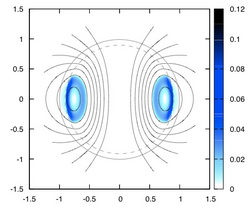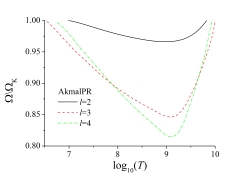Forschung 2013
Evolution of the f-mode instability in neutron stars and gravitational wave detectability
April 2013
Andrea Passamonti, Erich Gaertig, Kostas D. Kokkotas, Daniela Doneva
A nascent neutron star, if rapidly rotating, may develop non-axisymmetric instabilities and radiate a significant amount of gravitational waves. One of the possible processes that can drive unstable a nonaxisymmetric mode is the well-known Chandrasekhar-Friedman-Schutz (CFS) mechanism. This instability operates when a mode which is counterrotating with respect to the star is seen as corotating by an inertial observer. The angular momentum which is then radiated by gravitational waves induces an increasingly negative angular momentum of the mode which becomes unstable.
The mode's amplification expected during the instability may generate a significant gravitational wave signal which can be potentially observed by the current and next generation of Earth-based laser interferometers. When the gravitational waves will be observed, the identification of the oscillation modes from the spectrum will help us to unveil the properties of the dense matter at super-nuclear densities and clarify the neutron star physics.
In this work we present the first dynamical study of the f-mode instability which considers relativistic rapidly rotating stars and incorporates the effect of viscosity, magnetic fields, and unstable r-modes. These are the most dominant effects which may have a significant impact on the evolution of this mode.
Considering several neutron star's models with polytropic equation of state we find that the gravitational-wave signal generated by an unstable f-mode may be potentially detected with the Einstein telescope (ET) from a source located in the Virgo cluster (20Mpc). For the more massive stellar model the signal may be even detected by the Advanced LIGO/Virgo detectors. Moreover, we found that the heat generated by shear viscosity during the saturation phase of an unstable f-mode may counterbalance the neutrino cooling and prevents the star from having superfluid transitions during the instability. The star then spends more time in the instability region and loses more angular momentum via the emission of gravitational waves.
Phys. Rev D 87, 084010 (2013) arXiv:1209.5308v1 [astro-ph.SR]
The magnetic field within a superconducting neutron star
February 2013
Sam Lander
Superfluidity and superconductivity only occur on the Earth in special materials at extremely low temperatures. By contrast, these exotic states of matter are expected to be commonplace in neutron stars: the neutrons form a superfluid and the protons a superconductor. In 'normal' matter - main-sequence stars, white dwarfs and most material on Earth - the magnetic force that acts on charged particles is the familiar Lorentz force. For superconducting matter the magnetic force is quite different - but most work on neutron stars still uses the Lorentz force anyway, for simplicity.
Here we lay some foundations for including proton superconductivity in neutron star models. We derive a single equation governing an equilibrium magnetic field in a superconductor and solve it numerically. Our solutions show qualitative differences from earlier models that assumed normal matter.
Phys. Rev. Letters, 110, 1101 (2013) arXiv e-print (arXiv:1211.3912)
Stratification, superfluidity and magnetar QPOs
November 2012
Andrea Passamonti, Sam Lander
Magnetars are slowly rotating neutron stars with a strong magnetic field. Three of these objects have been seen to produce enormously energetic ‘giant flares’. Quasi-periodic-oscillation (QPOs) were detected in the flare’s decaying X-ray tail, between 100 and 400 s after the initial burst, and a number of frequencies were identified within each tail, of varying duration and intensity. The quasiperiodic oscillations of magnetars provide an exciting possibility of probing the interior physics of neutron stars, as they are thought to relate directly to oscillation modes of the underlying star. We have studied the time evolution of non-axisymmetric oscillations of purely two-fluid stars with superfluid neutrons and normal (not superconducting) protons. We have considered various magnetic field geometries, proton fractions, entrainment and composition stratifications and analysed their impact on the Alfvén mode spectrum. We find that a ‘typical’ multifluid magnetar could have QPO frequencies which are roughly a factor of 5 or 6 higher than expected from a single-fluid unstratified model (see equation).
MNRAS 429, 767 (2013) arXiv:1210.2969v1
Gravitational wave asteroseismology of fast rotating neutron stars with realistic equations of state
May 2013
Daniela D. Doneva, Erich Gaertig, Kostas D. Kokkotas and Christian Krüger
Fast rotating neutron stars can be destabilized by the so-called Chandrasekhar-Friedman-Schutz (CFS) instability, i.e. certain nonaxisymmetric oscillation modes can become unstable due to the emission of gravitational radiation for very high rotation rates of the star. If the requirements for this instability are met, the amplitude of the modes will grow exponentially even if they are only weakly excited which could potentially lead to detectable amount of gravitational radiation. Such high rotational rates are supposed to be observed for example in the newborn neutron stars.
One of the major challenges following the detection of gravitational waves from oscillating neutron stars is to infer its characteristic parameters like mass, radius and rotation rate via the observed data. In order to do that, we should build accurate theoretical models. That is why we study quadrupolar and higher order oscillations of fast rotating neutron stars within the Cowling approximation, where some of the modern realistic equations of state of the nuclear matter are employed. We derive improved empirical relations for gravitational wave asteroseismology with f -modes which connect the observed frequencies and damping times to the mass, radius and rotational rate of the neutron stars.
We also compute the instability window for certain models, i.e. the range of parameter where the CFS instability overcomes the dissipative effects. It turns out that the window can be larger when realistic equations of state are considered compared to the polytropic case.
Phys. Rev. D 88, 044052 (2013) arXiv:1305.7197 [astro-ph.SR]



